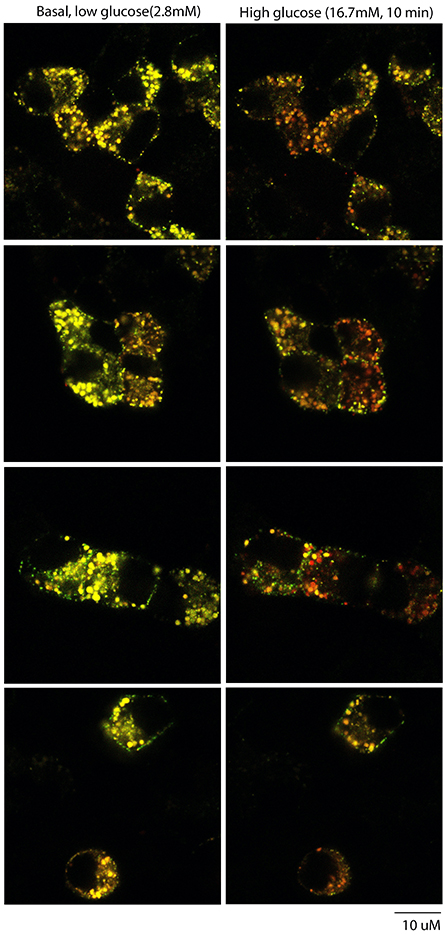Sorting and secreting insulin
by expiration date
A study in the Journal of Biological Chemistry describes a new way to determine the age of insulin-storage parcels, known as granules, and sheds light on how their age affects their release into the bloodstream. The findings could help experts better understand diabetes and fine-tune therapies for it.

Insulin is a hormone that manages the level of sugar, or glucose, in the bloodstream. It is secreted by the pancreas into the bloodstream when blood sugar levels rise. When insulin circulates in the bloodstream, muscle and other cells absorb glucose to use it as fuel, and so blood sugar levels decline. In Type 2 diabetes, formerly known as adult-onset diabetes, this process fails. Glucose builds up in the blood, either because the pancreas cannot produce enough insulin to keep up with dietary sugar intake or because the gland simply isn’t working as it should.
About one in 10 Americans and more than 415 million people worldwide have diabetes, according to the Centers for Disease Control and Prevention. Up to 95% of them have Type 2. Treatment often requires painful and frequent insulin injections or the use of mechanical insulin pumps. There is no cure.
The researchers noted in their paper that existing therapies for diabetes increase insulin secretion without regard for insulin granule age. “Accordingly,” they wrote, “these approaches are effective only for a short period.”
Insulin is produced by beta cells of the pancreas and stored in insulin granules, which are then organized into pools and finally secreted into the bloodstream. Pools of young insulin granules are preferred for secretion over pools of old ones, for reasons that remain unclear.
The scientists whose work was published in JBC wanted to learn more about how pancreatic cells can distinguish between pools with young or old insulin granules.
“Current therapeutics do not take the existence of pools into consideration,” said Melkam Kebede, an assistant professor at the University of Sydney who oversaw sthe study. “By evolution, the (pancreatic) cells have determined what to secrete and what not. Understanding the mechanism and molecular differences between the pools definitely is going to lead us into something meaningful.”
In their paper, the researchers describe a technique they developed to distinguish younger insulin granules from older ones. The scientists placed a fluorescent protein, called Syncollin-dsRedE5TIMER, into newly created insulin granules and used a laser and detector to visualize that marker. In younger granules, the marker emits a green fluorescent light; as granules get older, the marker begins to emit a red fluorescence.
The authors monitored the movements of and other changes in insulin granule pools and saw that, as predicted, both mouse and human cells preferentially release younger insulin granule pools into the bloodstream in response to glucose.
The researchers then set out to learn more about how pancreatic cells sort insulin granules into pools and release them when they are experiencing metabolic stress. The concern is that, when under stress, beta cells “could potentially lose their ability to distinguish young (granules) from old,” they wrote in their paper.
The team isolated beta cells from mice and simulated chronic low, high and normal blood sugar levels and found different glucose levels determine which pools of insulin granules, young or old, are secreted. They saw similar results when they used a common mouse model for Type 2 diabetes known as the db/db mouse.
These findings are important, Kebede said, because “all the drugs that affect insulin secretion…just push any granule within the cell and eventually fail.”
Older insulin granules are naturally degraded in normally functioning beta cells, noted lead author Belinda Yau of the University of Sydney, but, in diabetes, a greater percentage of insulin granule pools are secreted, and there’s a mismatch in how they’re released.
Being able to visualize insulin granules as they age and understanding better how their age affects their secretion may lead to the discovery of new biomarkers capable of indicating the development of diabetes and could help in the creation of therapies for Type 2 diabetes.
“If we can understand what makes up the granules and makes them do what they do, we can figure out a way to target the things that slow down or speed up their secretion,” Yau said.
Enjoy reading ASBMB Today?
Become a member to receive the print edition four times a year and the digital edition monthly.
Learn moreGet the latest from ASBMB Today
Enter your email address, and we’ll send you a weekly email with recent articles, interviews and more.
Latest in Science
Science highlights or most popular articles

The science of staying strong
Muscles power every movement, but they also tell the story of aging itself. Scientists are uncovering how strength fades, why some species resist it and what lifestyle and molecular clues could help preserve muscle health for life.

Bacteriophage protein could make queso fresco safer
Researchers characterized the structure and function of PlyP100, a bacteriophage protein that shows promise as a food-safe antimicrobial for preventing Listeria monocytogenes growth in fresh cheeses.

Building the blueprint to block HIV
Wesley Sundquist will present his work on the HIV capsid and revolutionary drug, Lenacapavir, at the ASBMB Annual Meeting, March 7–10, in Maryland.

Gut microbes hijack cancer pathway in high-fat diets
Researchers at the Feinstein Institutes for Medical Research found that a high-fat diet increases ammonia-producing bacteria in the gut microbiome of mice, which in turn disrupts TGF-β signaling and promotes colorectal cancer.

Mapping fentanyl’s cellular footprint
Using a new imaging method, researchers at State University of New York at Buffalo traced fentanyl’s effects inside brain immune cells, revealing how the drug alters lipid droplets, pointing to new paths for addiction diagnostics.

Designing life’s building blocks with AI
Tanja Kortemme, a professor at the University of California, San Francisco, will discuss her research using computational biology to engineer proteins at the 2026 ASBMB Annual Meeting.

